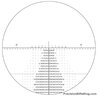Dr T
Member
There are few things that I find more satisfying than shooting a one-hole group with my hunting rifle. Indeed, given the improvements in the quality of factory built rifles, optics, and ammunition, it is rather common to find an off the shelf rifle that will hold a 1" three shot group at 100 yards with no tweaking. There is an entire generation of shooters that are used to this quality, so that when things go a bit south, they may be a bit confused on how to correct the situation.
Which brings me to the subject of my post. Back in what my children think of as the OLDEN DAYS, it was unusual to find a rifle that would perform well out the box. A lot of us learned to shoot with 22's with sights that could be referred to optimistically a mediocre. If you were about to shoot a buddy's 22 at a jackrabbit you would typically ask "How does this shoot" and get an answer about like "High and a little to the left." You would then make the suggested correction in the aim and shoot. If you missed, and the rabbit was still around, you make another correction based on the observed point of impact (it is dry in West Texas and bullets would kick up dust when they hit) and shoot again. There were a lot of hares, so you got lots of practice. Fundamentally, the sights suggested where to point the gun and the rest was based on adjusting the aim to the observed point of impact.
How does this translate to the situation today? I have found that few of my rifles will hold zero when I go from Denver at 5280 ft altitude to West Texas at 2300 feet altitude. And travel tends to knock sights around. In the best circumstances, I go and carefully re-zero the rifle. But sometimes the circumstances are not at the best, and you have to go back to the old fashioned way. Such circumstances include your scope getting a hard knock on something hard while getting out of the truck or off the horse. Or you need to grab your 22 in a hurry because of the rattlesnake you nearly stepped on. This is why I practice on reactive targets..
Come to think of it, this technique is formalized by the two-man sniper team with a spotter and a shooter. But they shoot with a lot more precision that I could ever obtain.
Which brings me to the subject of my post. Back in what my children think of as the OLDEN DAYS, it was unusual to find a rifle that would perform well out the box. A lot of us learned to shoot with 22's with sights that could be referred to optimistically a mediocre. If you were about to shoot a buddy's 22 at a jackrabbit you would typically ask "How does this shoot" and get an answer about like "High and a little to the left." You would then make the suggested correction in the aim and shoot. If you missed, and the rabbit was still around, you make another correction based on the observed point of impact (it is dry in West Texas and bullets would kick up dust when they hit) and shoot again. There were a lot of hares, so you got lots of practice. Fundamentally, the sights suggested where to point the gun and the rest was based on adjusting the aim to the observed point of impact.
How does this translate to the situation today? I have found that few of my rifles will hold zero when I go from Denver at 5280 ft altitude to West Texas at 2300 feet altitude. And travel tends to knock sights around. In the best circumstances, I go and carefully re-zero the rifle. But sometimes the circumstances are not at the best, and you have to go back to the old fashioned way. Such circumstances include your scope getting a hard knock on something hard while getting out of the truck or off the horse. Or you need to grab your 22 in a hurry because of the rattlesnake you nearly stepped on. This is why I practice on reactive targets..
Come to think of it, this technique is formalized by the two-man sniper team with a spotter and a shooter. But they shoot with a lot more precision that I could ever obtain.


